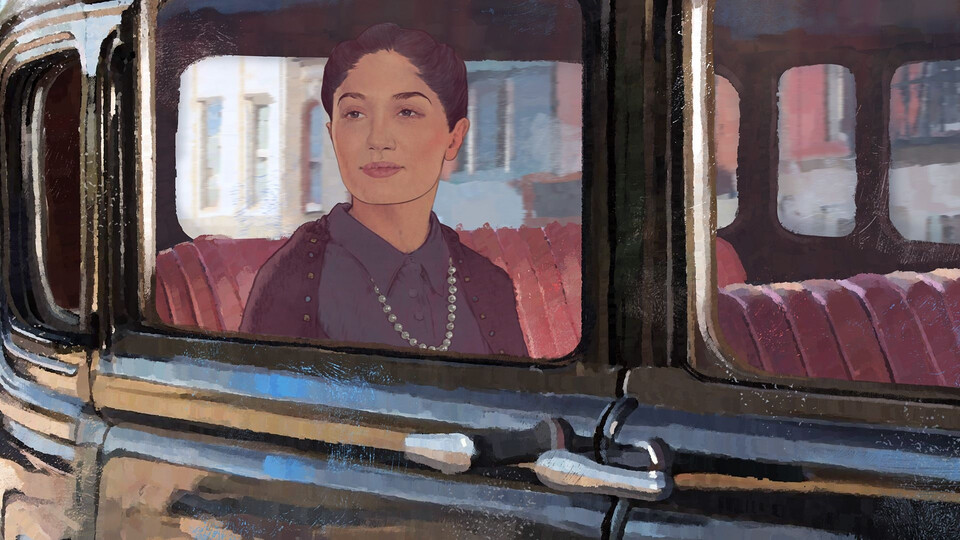Slow Yoon, a slow journey
The film Yoon, the romanticisation of road movies, and the concept of slowness.
Among the screenings at the festival in Jihlava was the premiere of Yoon (2021) by directors Pedro Figueiredo Neto and Ricardo Falcão. The film follows Mbaye on his long journey from Portugal to Senegal. He makes the trip in an old Peugeot full of luggage that he has to transport across the border for his customers. From this short description alone, it is clear that Yoon is a road movie; however, in many regards it is a revolutionary road movie.
The fiction films Waiting for Happiness (2002) and Morgen (2010) can also be considered road movies, and according to Michael Gott, given their form, the label of slow cinema fits them as well. In his text in the collection Slow Cinema, Gott mentions that the slowness of these films stems from their emphasis on pauses in the journey that force the characters into long waits. And it is precisely this waiting that gives both films their slow pace.1) In Yoon, however, the slowness lies in the journey itself. So why, then, did I detour to fictional road movies? Because Yoon de-romanticises not only this genre but above all the motif of the journey – in non-fiction and fiction films alike.
The slowness and monotony of the journey is created through various stylistic devices, but the film does not rely on extremely long-duration shots alone, as is the case, for example, in the documentary works of Sharon Lockhart or James Benning. The directors of Yoon often make use of silence or minimalistic music, incessant phone calls from customers, and very frequent shots from inside the car, in which the focus is on the car window and the surroundings and often Mbaye himself are out of focus. Thus, in many instances the filmmakers do not concentrate on capturing photogenic images of the landscape, as is often the case with other slow films, and we occasional even watch shots of absolute darkness. In the films of Yasujirō Ozu or Sharon Lockhart’s experimental documentary Double Tide (2010), we observe the slow movements of the actors, and a similar situation occurs here too. The sluggish movement is driven to the extreme in occasional slow-motion shots. Furthermore, there is not even any emphasis placed on the tension that Mbaye experiences, for example, at customs crossings.
In these moments, Yoon highlights the danger of Mbaye’s journey, which stems from the political instability of Western and sub-Saharan Africa. The situation in Senegal is particularly dangerous because it is part of the Sahel, where various terrorist groups operate. The turmoil in African countries was obviously one reason for the film’s abundance of shots inside the car – it was very dangerous to film outside in some areas. In this way we also come to learn about the difficulties the directors encountered when trying to film in these African regions. At the border crossings, they had to hide from the customs agents – something Mbaye helped them out with many times. We don’t learn much about Mbaye as there was a lot of information he didn’t want to share about himself. Moreover, he had to drive slowly to avoid destroying his old car before the they reached their destination. During the discussion after the screening in Jihlava, the filmmakers also explained that Mbaye doesn’t listen to music on his journeys because he has to concentrate on the sounds of the car to see if everything is working properly.
Thanks to the slow form that the filmmakers adopted and supported with other formal elements, we can easily empathise with the protagonist, who constantly battles monotony and boredom during his trip. The filmmakers thus managed to depict the journey as it truly is. However, Yoon and slow cinema in general bring with them a certain challenge. To fully experience the film, we must attune ourselves to the slow pace, to focus our attention. If we succumb to boredom, we miss out on powerful moments. To explain this, we can use an analogy with the results of the experiments of the founder of experimental psychology, Ernst Heinrich Weber. In short, he revealed that at lower standard stimulus intensities, we register changes in stimulus intensity much more.2) Thus, if we watch a slow, monotonous film, attune ourselves to its pace, and focus our attention, even stimuli that would be regarded as banal in “faster” films can have a strong effect on us.
We therefore find Mbaye’s watching a video on his phone or a bizarre movie on TV more entertaining, and we view the protagonist’s face-to-face communication with another person as a big event. It’s the same when he repairs and polishes his old car; we are able to view the vehicle as Mbaye does – no longer as just an old car but as an essential means of survival and security for his family. The juxtaposition of the African masks and the crushing phone calls at the end of the film, hinting at his future journeys, also has a stronger effect on us. Thanks to its innovative combination of aspects of the road movie and slow cinema, Yoon is a very emotional film. The film properly conveys the feelings Mbaye experiences on his travels and by doing so informs the audience about the hardships in Africa from a different, unusual perspective, thanks to which it has a more intense impact on the viewer.
---
Notes
1) GOTT, Michael. The Slow Road to Europe: The Politics and Aesthetics of Stalled Mobility in Heremakono and Morgen. In: Tiago de Luca a Nuno Barradas Jorge (eds.). Slow Cinema. Edinburgh: Edinburgh University Press, 2016, p. 299–311.
2) PLHÁKOVÁ, Alena. Učebnice obecné psychologie. Prague: Academia, 2003, p. 102.
This article is a result of the project Media and documentary 2.0, supported by EEA and Norway Grants 2014–2021.






